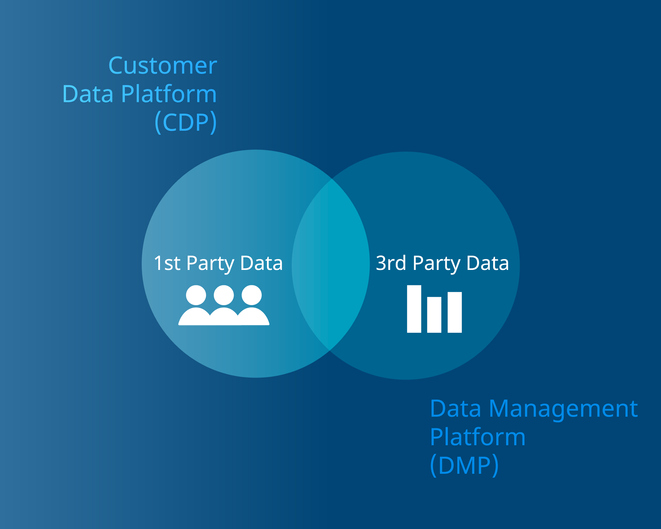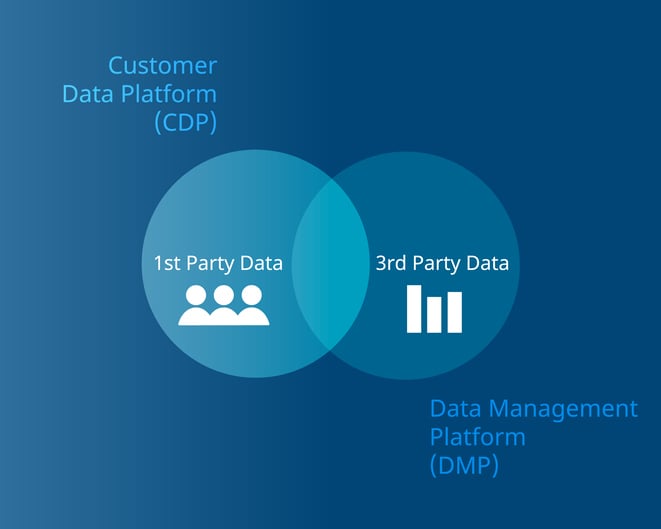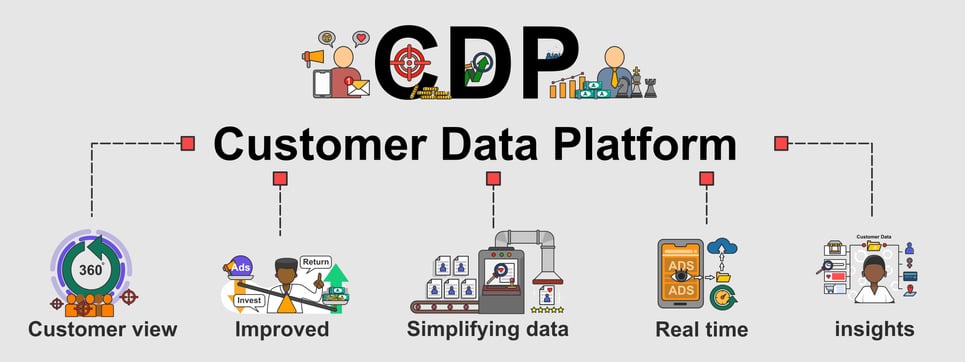

DMP vs CDP - What's the difference and what should you be using?


DMPs and CDPs are the new marketing buzzwords. But what do they mean?
DMPs and CDPs are both tools that marketers use to better understand their customers, but there are important differences to understand before deciding which will work best for your Enterprise.
DMPs and CDPs: Understanding the basics
DMP stands for Data Management Platform. DMP is a system that gathers information about your customers on their media channels (e.g. Google search history) and then stores it centrally in order to use that information to show relevant content and ads to your customers.
DMPs are used by marketers to understand what is important for each customer segment and uses that information to strategically target them with the most relevant, impactful messages across all their touch points. DMPs also give you more insight into how well your ad campaign is doing so you can adjust its targeting.
CDP is a Customer Data Platform and works with First Party Data. It does not require any Third Party data to work. CDP's best use case is that it stores all your First Party Data from all customer touch-points, which you can then use to personalise the experience across multiple channels, including email marketing, website personalisation, CRM systems and ad platforms.
First party data vs third party data
DMPs are reliant on third party data to function - a DMP is mostly used with social media data and uses cookies/IP location/search info etc. A DMP stores the information of your customers so you can retarget them on their personal mediums (e.g Google search history). A CDP on the other hand works with your First-party data, i.e. your CRM information as well as transactional data from your business systems that can all be streamed into the CDP in real time to build out a 360 view of your customer.

DMPs drive Ad Targeting
DMPs are used by marketers to understand what is important for each customer segment and uses that information to strategically target them with the most relevant, impactful messages across all their touch points. DMPs also give you more insight into how well your ad campaign is doing so you can adjust your targeting. However, DMPs are reliant on third party data to function - a DMP is mostly uses cookies/IP location/search info collected from the Internet. The DMP stores the information of your customers so you can retarget them on their personal mediums (e.g Google search history).
DMPs provide a way for businesses to identify potential customers before they have converted into buyers or opted into marketing lists which makes them more controllable and easier to quantify ROI on. They also allow companies that have collected information about their consumers from multiple sources (e.g social media platforms) to find potential new customers that have similar interests and behaviours. DMPs store the Cookie IDs of users visiting your Website and can then be used to match these IDs against third party data sources from Advertising platforms.
CDPs provide a 360 View of your Customer
Most importantly, a CDP allows you to bring together all your customer related information into a single platform to provide a single source of truth on your customers. This is done by streaming your CRM data as well as transactional data from your business systems into the CDP in real time to build out a 360 view of your customer. CDPs are starting to grow in popularity because of the higher level of automation that CDPs offer as well as the more comprehensive scope that they offer which DMPs don't have access to.

DMPs are in decline compared to CDPs.
DMPs are becoming obsolete, so companies should migrate their data to a CDP.
There are several reasons why companies should migrate their data from a DMP to a CDP. DMPs are becoming less popular because of the rise of CDPs which are much more comprehensive in scope.
CDPs also have a much higher level of automation which is crucial for marketers who want to scale their campaigns.
DMPs are also less comprehensive in terms of the data that they collect, whereas CDPs collect all first-party data including transactional data from your business systems in order to build out a 360 view of your customer.
Finally, DMPs are reliant on third-party data to function whilst CDPs work with your first-party data. With concerns over data privacy growing, its becoming harder for businesses to leverage Cookie IDs to identify and target audiences. As such, it is imperative that companies make the switch from DMPs to CDP if they want to move their marketing campaigns into the age of AI and automation.
DMPs and CDPs are both important to your marketing strategy, DMPs allow you to track and retarget customers across different mediums whereas CDP gives you a 360 view of the customer. DMPs are starting to become obsolete because they can't compete with the more comprehensive scope that CDPs offer which has been made possible by automation features such as streaming CRM data from business systems into the platform in real-time. Therefore, if you want an edge on competitors who haven't already migrated their DMP information over to a CPD, now's probably a good time!
Some CDP platforms to check out:
Datorama
Datorama is a customer data platform that provides marketers with the ability to create personalised ads for their customers. Datorama's DMP integrates all of your CRM information, transactional data from your business systems, and third-party data sources into one comprehensive view of your customer. Datoramas DMP streamlines targeting across different channels (e.g Google search history) by using cookie IDs to match online visits against third party data sources like social media platforms or advertising platforms like Facebook Ads Manager
Datarama has made it possible for companies to scale their marketing campaigns by providing them with access to insights on how well their ad campaign is doing via its DMP which they can then use as an opportunity to adjust accordingly.
Tealium
Tealium is a customer data platform that helps marketers build personalised, relevant experiences for every customer. its power lies in its large selection of ready-made connectors to many commonly used Enterprise systems.
Is also has a built in ETL engine that simplifies the process of transforming and matching data between disparate systems. It also has a Rules Engine and external hooks that can drive marketing automation.
Tealium is available as a Cloud Service - making on-boarding straight forward and relatively painless.
Segment
Segment is a customer data platform (CDP) that helps you collect and unify your customer data. Segment understands what your users are doing both on and off your website, allowing you to send events and page views to dozens of other tools like Google Analytics, Salesforce DMP & Datorama for more effective marketing intelligence and analysis
So what should you do in 2022?
DMPs are starting to become obsolete because they don't have the same level of comprehensiveness as CDPs. DMPs can only track customers across different medium, while CDP offers a 360 view of the customer. DMP is becoming less popular thanks in part because it can't compete with the more comprehensive scope that CPD offers which has been made possible by automation features such as streaming CRM data from business systems into the platform. This means if you want an edge on competitors who haven't already migrated their DMP information over to a CPD, now's probably a good time!
---
Every year, B2B companies spend millions of dollars on marketing and advertising to attract new customers. Yet they struggle to understand how their efforts are performing and what is working for them.
At Construct Digital we help our clients gain a deeper understanding of their digital marketing performance by providing insights into the customer journey through the use of technology-driven solutions such as Google Analytics 360, AdWords, Facebook Ads, Marketing Automation and CRM. We also provide strategic consultancy services in areas such as SEO, Content Marketing and Social Media Advertising.
With an end-to-end approach that combines Creative strategy with execution, leveraging technology tools like Google Analytics 360 & Hubspot Marketing Automation we can help you achieve your business goals faster than ever before! Talk to us.
More insights